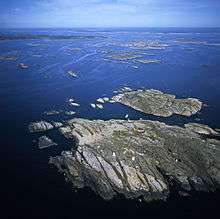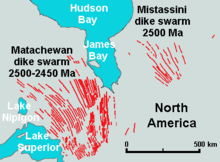Dike swarm



A dike swarm or dyke swarm is a large geological structure consisting of a major group of parallel, linear, or radially oriented dikes intruded within continental crust. They consist of several to hundreds of dikes emplaced more or less contemporaneously during a single intrusive event, and are magmatic and stratigraphic. Such dike swarms may form a large igneous province and are the roots of a volcanic province.
The occurrence of mafic dike swarms in Archean and Paleoproterozoic terrains is often cited as evidence for mantle plume activity associated with abnormally high mantle potential temperatures.
Dike swarms may extend over 400 km (250 mi) in width and length. The largest dike swarm known on Earth is the Mackenzie dike swarm in the western half of the Canadian Shield in Canada, which is more than 500 km (310 mi) wide and 3,000 km (1,900 mi) long.[1]
The number of known giant dike swarms on Earth is small, only about 25. However, the primary geometry of most giant dike swarms is poorly known due to their age and subsequent tectonic activity.
Dike swarms have also been found on Venus and Mars.[2][3]
Examples
Africa
- Cape Peninsula dyke swarm (South Africa)
- Okavango dike swarm (Botswana)
Antarctica
- Vestfold Hills dike swarms (East Antarctica)
Asia
- North China dike swarm (North China craton, China)
- Sayan dike swarm (Russia)
- Shirotori-Hiketa dike swarm (northeastern Shikoku, Japan)
Australia
- Gairdner dyke swarm (South Austalia)
- Mundine Well dyke swarm (Western Australia)
- Wood's Point dyke swarm (Victoria, Australia)
Europe
- Egersund dike swarm (southwest Norway)
- Kattsund-Koster dyke swarm (southeast Norway, Swedish west coast)
- Kildonan dyke swarm (Isle of Arran, Scotland)
- Kirov dike swarm (Russia)
- Scourie dyke swarm (northwest Scotland)
- Orano dike swarm (Elba, Italy)
- Satakunta dike swarms, Finland
- Sayda-Bergiesshuebel dike swarm (Saxony, Germany)
North America
Canada
- Bella Bella and Gale Passage dike swarms (central British Columbia Coast)
- Franklin dike swarm (Northern Canada)
- Grenville dike swarm (Ontario and Quebec)
- Mackenzie dike swarm (Northwest Territories, Nunavut, Saskatchewan, Manitoba and Ontario)
- Marathon dike swarm (northwestern Ontario)
- Matachewan dike swarm (eastern Ontario)
- Mistassini dike swarm (western Quebec)
- Sudbury dike swarm (northeastern Ontario)
Greenland
- Kangaamiut dike swarm (western Greenland)
United States
- Kennedy dike swarm (southeastern Wyoming)
- Magdalena radial dike swarm (central New Mexico)
- San Rafael Swell dike swarm (Utah)
- Warm Springs Mountain dike swarm (Nevada)
South America
- Dyke swarms associated with the Paraná and Etendeka traps
- Cuaró dyke swarm, Uruguay
- Eastern Paraguay dyke swarm[4]
- Ocros dyke swarm, Peru
- Uruguayan dyke swarms
- Florida dyke swarm
- Nico Perez dyke swarm
- Treinta y Tres dyke swarm
- Dyke swarms of Tandil and Azul, Buenos Aires Province, Argentina
See also
References
- ↑ Mackenzie dike swarm (geological feature, Canada) -- Britannica Online Encyclopedia.
- ↑ Galgana, Gerald A.; Grosfils, Eric B.; McGovern, Patrick J. (2013). "Radial dike formation on Venus: Insights from models of uplift, flexure and magmatism". Icarus. 225: 538–547. doi:10.1016/j.icarus.2013.04.020.
- ↑ Ernst, R.E.; Grosfils, E.B.; Mège, D. (2001). "Giant Dike Swarms: Earth, Venus, and Mars". Annual Review of Earth and Planetary Sciences. 29: 489–534. doi:10.1146/annurev.earth.29.1.489.
- ↑ Druecker, M.D.; Gay, Jr., S.P., Mafic Dyke Swarms Associated with Mesozoic Rifting in Eastern Paraguay, South America